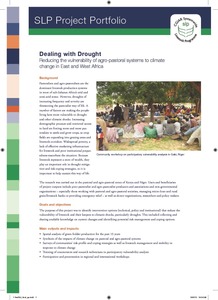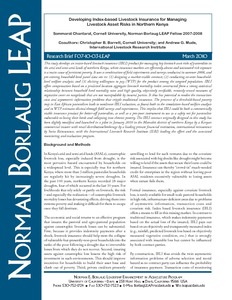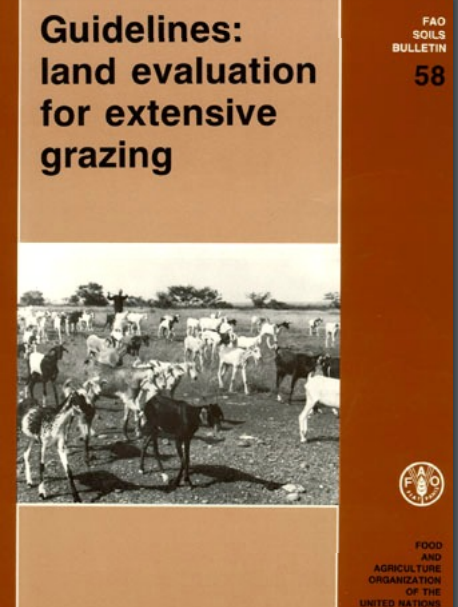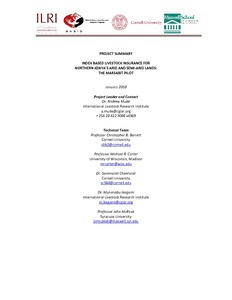Regulations on Bayinbuluk Grassland Ecological Protection.
The purpose of these Regulations is to protect construct and rational utilize Bayanbulak grassland, prevent grassland ecological degradation, improve the grassland ecological environment and promote sustainable economic and social development.The people's government of the autonomous prefecture should integrate the protection, development and use of grasslands into national economic and social development planning, and grassland protection, fire prevention and pest disaster prevention shall be included in the government budget.
Developing Index Based Livestock Insurance for managing livestock asset risks in Northern Kenya
This study develops an index-based livestock insurance (IBLI) product for managing key livestock asset risks of pastoralists in the arid and semi-arid lands of northern Kenya, where insurance markets are effectively absent and uninsured risk exposure is a main cause of persistent poverty.
Sitting at the table: securing benefits for pastoral women from land tenure reform in Ethiopia
The pastoral areas of Ethiopia are witnessing radical change in terms of both increasingly restricted mobility and access to vital resources. A cause and consequence of such constraints has been a move toward sedentarised forms of livestock and agricultural production. This is occurring in a political and socioeconomic vacuum, in which the customary institutions responsible for resource allocation and access to land are becoming weaker, and where the Ethiopian government has yet to develop a clear policy or strategy for resource distribution and tenure security in pastoral areas.
Explaining index based livestock insurance to pastoralists
Livestock production in arid and semi-arid rangelands is a risky enterprise. Covariate risk of catastrophic livestock loss due to drought is the most critical uninsured risk facing livestock producers. These losses can lead to persistent poverty. We are trying to design an index based livestock insurance (IBLI) program as a viable means to help pastoralists in northern Kenya manage such covariate risk of livestock losses due to drought.
Guidelines land evaluation for extensive grazing
Extensive grazing is the predominant form of land use on at least a quarter of the world’s land surface, in which livestock are raised on food that comes mainly from rangelands. The term livestock includes both domesticated animals such as cattle, sheep, goats, camels, horses, llamas and alpacas, and a broad range of wild animals kept for meat or game viewing. It is estimated that tropical grasslands alone cover 18 million square kilometres, where the natural vegetation is used by mobile animals requiring forage and water throughout the year.
Herders to benefit from livestock insurance
Thousands of livestock herders across the arid North Eastern Kenya can now rest secure, thanks to a new initiative that will shield them against loss of their livestock to drought. For the first time ever, a livestock insurance scheme has been introduced which will make use of satellite images to detect areas that could suffer from livestock loss.
Index based livestock insurance for northern Kenya’s arid and semi-arid lands: the Marsabit Pilot. Project summary
Innovation and Distress: Managing Multiple Uncertainties in Laikipia, Kenya
The research begins by describing the land access and tenure context in Laikipia, Kenya. The paper also incudes:
•• Pastoralism researchers analyse coping innovations during
the 2009 drought that pushed Maasai herders to Mount Kenya.
•• Despite previous brittle social relations, agreements between
ranchers and farmers permitted limited grazing of cattle and sheep inside commercial ranches on a controlled basis
Participatory Land Use Planning as a Tool for Community Empowerment in Northern Tanzania
This paper presents several case studies to show how the Ujamaa Community Resource Team (UCRT) has been working within Tanzania’s legal and policy framework to support a diverse range of pastoralists, agro-pastoralists and hunter-gatherers, all of whom face
fundamental threats from external appropriation of, or encroachment on, lands and natural resources. The work also responds to local needs to rationalise resource use rights amongst competing local groups, such as farmers and livestock keepers. By using participatory
Communal Land Registration
This brochure provides the necessary information for people living in communal areas to have their land rights registered. The brochure also tackles why land has to be registered; who is responsible for the various aspects of the process; and how land disputes are handled.









